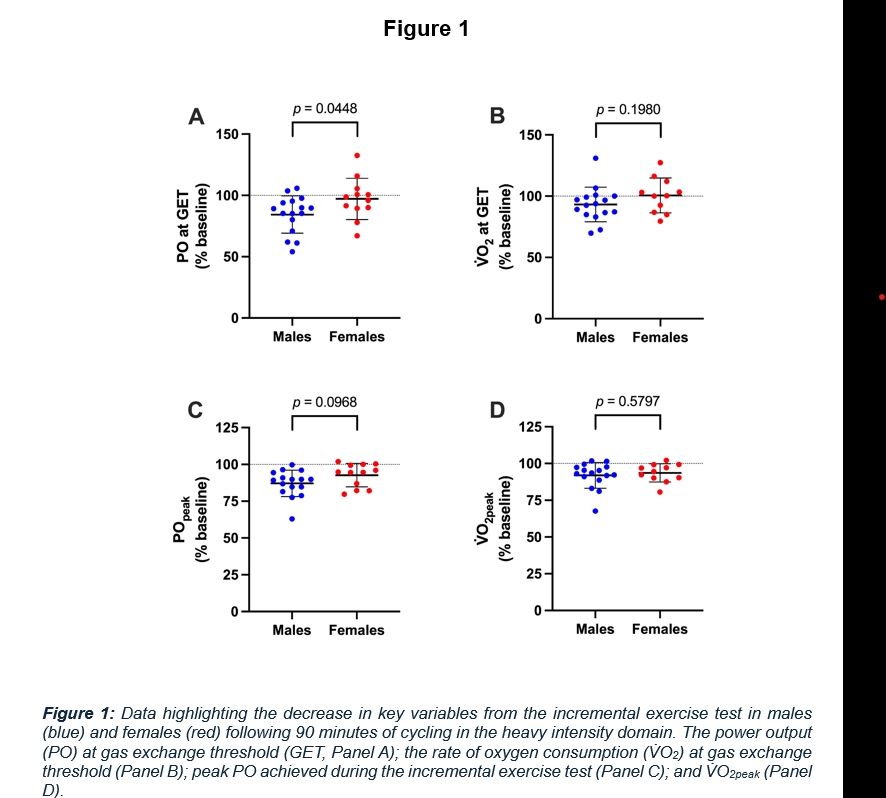Introduction: In cycling, a rider’s capacity to maintain high power outputs (PO) after accumulating a certain amount of work represents a key determinant of elite performance (1). Indeed, the most successful competitive male (M) road cyclists have shown a superior capability to minimise their reductions in the power output profile that occurs as exercise proceeds, also called “durability” (2,3). However, while females (F) are well reported to be more fatigue-resistant than M during various tasks (4), no research has compared durability between sexes.
Aims and objectives: This study aimed to investigate durability (measured as changes in submaximal and maximal markers of performance) and the underpinning physiological mechanisms in both sexes following 90 minutes of constant load cycling in the heavy intensity domain.
Methods: 28 trained cyclists and triathletes (16M, age 28±5 years, V̇O2peak 58±6 ml.kg-1.min-1 and 12F, age 27±4 years, V̇O2peak 52±3 ml.kg-1.min-1) visited the laboratory on two occasions. In visit 1, participants performed an incremental exercise test to exhaustion. In visit 2, participants performed 90 minutes (CWR) of heavy intensity cycling at 110% of gas exchange threshold (GET), followed by the same incremental test performed as in visit 1. During CWR, pulmonary gas exchange, heart rate (HR), and rating of perceived exertion (RPE) were recorded, and blood lactate (bLa) was collected. Before (PRE) and immediately after (POST) CWR, maximal voluntary isometric contraction force (MVIC), voluntary activation (VA) and potentiated twitches (100Hz, 10Hz, Qtw) of the knee extensors were assessed. Independent samples T-tests were used for the incremental test comparisons between sexes, and two-way repeated measures ANOVA (time x sex) was used to detect changes during CWR.
Results: PO at GET (M 226±42 vs F 139±27 W) and Peak PO (M 410±56 vs F 273±36 W) were higher in M vs F (both p<0.0001). During CWR, V̇O2, V̇CO2, V̇E, HR and RPE increased over time (all p<0.005), without sex differences. Time × sex interactions were detected for HR (p=0.0047) and V̇CO2 (p=0.0008), demonstrating greater increases in M. A sex effect was found for bLa, which was greater in M compared to F (p=0.0444) at 75 and 90 min. A time x sex interaction (p=0.0132) was found for the reduction in RER over time (p<0.0001), with greater values for M at 60, 75 and 90 min of exercise (p=0.0271). After CWR, PO at GET decreased more in M (-16±15%) than F (-3±17%, p=0.0448). Peak PO (M -13±9% and F -7±8%, p=0.0968) and V̇O2peak (M -8±9% and F -6±6%, p=0.5797) decreased similarly in both sexes. MVIC (-18±10%), potentiated twitches at 100Hz (-16±13%), 10Hz (-36±14%), Qtw (-29±13%), and VA (-6±7%), decreased from PRE to POST (all p<0.0002), without sex differences (p≥0.8707).
Conclusions: Females exhibited lesser reductions in submaximal threshold whereas data recorded at peak exercise decreased similarly in both sexes. No sex differences were observed in the changes in neuromuscular function. These results highlight the need to consider sex-specific training prescription and pacing strategies for long duration events. Data collection is still ongoing to reach an overall sample size of 32 participants.

